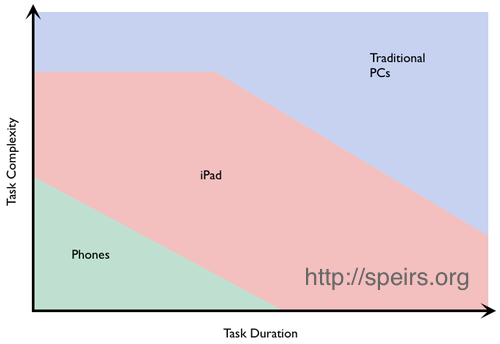I'm not trying to disparage iPads in any way. I've just never had anyone be able to explain to me why a tablet from Apple is a better educational device in all situations than a tablet from Samsung, for example.
Thursday, March 7, 2013
Language Shapes the Way We Think
Fraser Speirs has developed a nice framework to use in thinking about what type of device is the best for a particular task. While the traditional dichotomy is one-dimensional (consuming information vs creating information), Speirs proposes that we think about a two-axis chart, with task complexity on one axis and task duration on the other.
While I think this is a useful way to think about "the right device for the task", I have one major issue with this diagram. Why is the middle zone labeled "iPad" rather than "tablet"? The lower one is not labeled "iPhones". The upper one is not labeled "iMacs". The use of "iPad" as a generic name for a tablet device is (a) a triumph of Apple's marketing and (b) a hurdle for our district to overcome. As we investigate the best devices for district technology to purchase for teachers and students, more and more we come to Chromebooks and Android tablets, only to hear from teachers that they want "iPads". Some teachers can give very good justifications for why they want an iPad specifically; others are simply using the term as a shortcut for "tablet". Diagrams like the one above contribute to the confusion.
I'm not trying to disparage iPads in any way. I've just never had anyone be able to explain to me why a tablet from Apple is a better educational device in all situations than a tablet from Samsung, for example.
I'm not trying to disparage iPads in any way. I've just never had anyone be able to explain to me why a tablet from Apple is a better educational device in all situations than a tablet from Samsung, for example.
